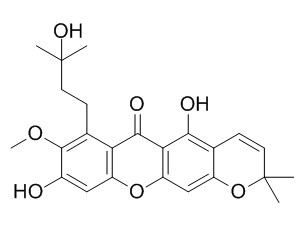9-Hydroxycalabaxanthone hydrate
The combination of 9-hydroxycalabaxanthone with α-mangostin showed the synergistic antimalarial interaction in both clones.
Inquire / Order:
manager@chemfaces.com
Technical Inquiries:
service@chemfaces.com
Tel:
+86-27-84237783
Fax:
+86-27-84254680
Address:
1 Building, No. 83, CheCheng Rd., Wuhan Economic and Technological Development Zone, Wuhan, Hubei 430056, PRC
Providing storage is as stated on the product vial and the vial is kept tightly sealed, the product can be stored for up to
24 months(2-8C).
Wherever possible, you should prepare and use solutions on the same day. However, if you need to make up stock solutions in advance, we recommend that you store the solution as aliquots in tightly sealed vials at -20C. Generally, these will be useable for up to two weeks. Before use, and prior to opening the vial we recommend that you allow your product to equilibrate to room temperature for at least 1 hour.
Need more advice on solubility, usage and handling? Please email to: service@chemfaces.com
The packaging of the product may have turned upside down during transportation, resulting in the natural compounds adhering to the neck or cap of the vial. take the vial out of its packaging and gently shake to let the compounds fall to the bottom of the vial. for liquid products, centrifuge at 200-500 RPM to gather the liquid at the bottom of the vial. try to avoid loss or contamination during handling.
J Agric Food Chem.2015, 63(44):9869-78
Biomed Pharmacother.2024, 181:117658.
J Nat Med.2017, 71(2):457-462
Molecules.2022, 27(7):2360.
J Ethnopharmacol.2017, 198:205-213
J Biomol Struct Dyn.2022, 5;1-17.
Naunyn Schmiedebergs Arch Pharmacol.2017, 390(10):1073-1083
Drug Test Anal.2018, 10(10):1579-1589
Gene.2022, 815:146178.
Antioxidants (Basel).2020, 9(6):526.
Related and Featured Products
Acta Parasitologica, 2014, 60(1).
The in vitro antimalarial interaction of 9-hydroxycalabaxanthone and α-mangostin with mefloquine/artesunate.[Reference:
WebLink]
Multidrug resistance Plasmodium falciparum is the major health problem in Thailand. Discovery and development of new antimalarial drugs with novel modes of action is urgently required.
METHODS AND RESULTS:
The aim of the present study was to investigate the antimalarial interaction of 9-hydroxycalabaxanthone and α-mangostin with the standard antimalarial drugs mefloquine and artesunate in chloroquine sensitive (3D7) and chloroquine resistant (K1) P. falciparum clones in vitro. Median (range) IC50 (drug concentration which produces 50% parasite growth inhibition) values of the 9-hydroxycalabaxanthone, α-mangostin, artesunate and mefloquine for 3D7 vs K1 clones were 1.5 (0.9-2.1) vs 1.2 (1.1-1.6) μM, 17.9 (15.7.0-20.0) vs 9.7 (6.0-14.0) μM, 1.0 (0.4-3.0) vs 1.7 (1.0-2.5) nM, and 13.3 (11.1-13.3) vs 7.1 (6.7-12.2) nM, respectively. Analysis of isobologram and combination index (CI) of 9-hydroxycalabaxanthone with artesunate or mefloquine showed synergistic and indifference antimalarial interaction, respectively. α-mangostin-artesunate combination exhibited a slight antagonistic effect of antimalarial interaction, whereas α-mangostin and mefloquine combination showed indifference interaction in both clones.
CONCLUSIONS:
The combination of 9-hydroxycalabaxanthone with α-mangostin showed the synergistic antimalarial interaction in both clones.



